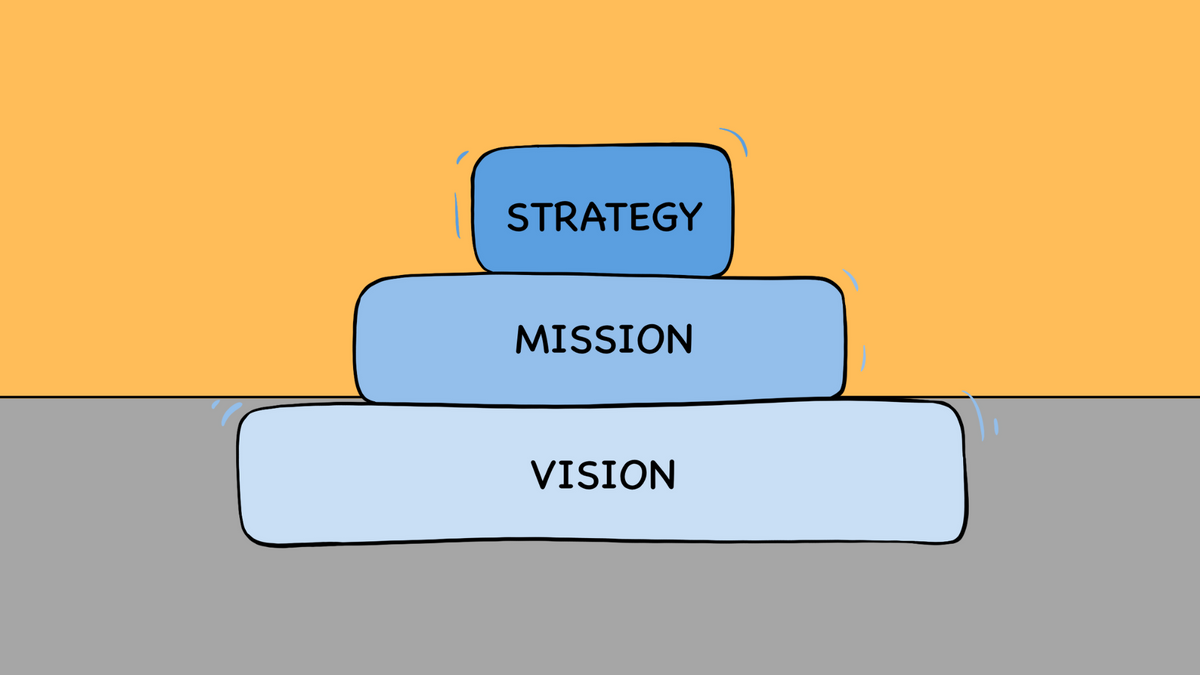Every organization exists for a reason (a vision) and has a guide to achieve this vision (a mission). It's undeniable that in order to succeed, your startup needs vision and mission statements stated clearly and unambiguously.
For a primer on what these must consist of and how to draft your organization's own vision and mission statements, check out our primer and template.
Getting started with organizational strategy
But wait, why are we talking about these statements when we ought to be explaining how to develop organizational strategies for your startup? Let us explain.
Think of your mission as your destination, and your vision as to why you want to be there in the first place. Your organizational strategy is the roadmap you need to get to where you want to be.
In corporate lingo, this ‘organizational strategy’ is a long-term business plan that helps guide you towards a meaningful goal. Sounds important, right? It sure is, and that’s because organizational strategy provides consistency in approaching common goals, besides simplifying and prioritizing decision-making.
After all, if you know where you are headed clearly, it makes navigating every decision simpler and—more importantly—consistent.
Take an organizational strategy example of ‘diversification’. If this is one of your important organizational strategies then decisions around marketing budgets, market research, branding, and new product development will be automatic, focused, and consistent across the organization.
Moving beyond the definition, how to create an organizational strategy and build a strategic roadmap is a vexing question. The solution—as always, break it up into parts.

The 3 tiers of an organizational strategy
Let’s try to understand the three types of organizational strategies with the help of Tesla’s vision and mission statement.
Tesla's vision statement: To accelerate the world’s transition to sustainable energy.
Tesla's mission statement: To create the most compelling car company of the 21st century by driving the world’s transition to electric vehicles.
Corporate organizational strategy
The steps here will be tied to Tesla’s vision and mission. The roadmap for a strategic plan could be, ‘Design and manufacture of reliable electric vehicles at competitive prices’.
Business organizational strategy
This part of your organizational strategy will detail out the steps to achieve the corporate organizational strategy listed above, including specific action points like, ‘Position Tesla’s electric vehicles as a viable and equal alternative to ICE vehicles.’
Functional organizational strategy
Here, you have more granular steps for each business function (marketing, finance, manufacturing, supply chain, etc.) that allow you to achieve your business strategy, such as, ‘Build an ecosystem of specialized vendors for high-end electronic and electrical components, particularly lithium-ion batteries built to Tesla specs’. For HRM, it could be, ‘Focus on building engineering talent across the organization that can deliver to standards.’
The 3 focus areas of an organizational strategy
For a startup, each of its organizational strategies will be driven by one or more of the following categories that are critical to the vision and mission and hence to the organizational business plan:
Revenue
Startups aiming for high growth rates, scale, valuations, etc., focused on growth strategies. Organizational strategy imperatives will be product/market expansion, aggressive customer acquisition, expanding marketing, pricing, etc.
Product or innovation
Startups looking to disrupt, change the status quo, challenge incumbents, etc. (such as Tesla), focused on transformational strategies. Here, organizational strategy imperatives could be centered around innovation, market disruption, developing product/service alternatives, etc.
People
Startups focused on employee development and building deeper bonds with customers. Organizational strategy for such startups would be focused on developing a unique internal culture, having a ‘people first’ approach, and offering customers an experience that builds loyalty. Southwest Airlines is a great example - it obsesses over keeping its employees happy in the (now proven) belief that happy employees mean happy customers mean happy shareholders!

3 Tips for an effective organizational strategy
Now that we've detailed the three most important tiers and focus areas of organizational strategy, let's give you three vital tips to make them stick. No matter what level or which focus area you are working with, these three tips for building organizational strategies will help you be in tune with your objectives:
Involve others
Your team will play a huge part in whether your startup makes it or sinks like a stone. It's therefore extremely vital to have them be a part of your interactions. Conducting high-quality exchanges will lead to a sense of involvement, more skin in the game, and buy in from others, besides better thought through outcomes.
Be transparent
Sharing ideas with your team and listening to these thoughts must be done in in a transparent environment. Fostering an environment of this sort helps people be accountable, feel engaged and safe. Not to mention that this is great way to build community!
Think critically
Last, but definitely not the least, understand that critical thinking and innovation go hand-in-hand. In order to make the most of organizational critical thinking, it is going to be important for you to involve potential critics in the process. In fact, there's a great chance they may turn out to become your best collaborators!
When you break down the basics of successful organizational strategy into these three quadrants, thrice over, it becomes easier to approach your building plans step-by-step. Remember, it's a marathon, not a sprint. Take critical and structured steps towards organizational building through strategies, stick with your statements, and plan for it to come to fruition at its pace. Good luck!


